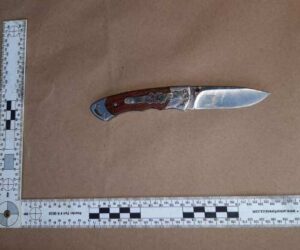
Peyton Ham, 16, of Leonardtown
The Office of the State’s Attorney in St. Mary’s County has completed its review of the fatal shooting of Peyton Ham, 16, of Leonardtown, on April 13, 2021, by Maryland State Police Trooper Joseph Azzari.
The report states the following:
“Based upon our investigation and analysis, we find that the intentional actions of Ham triggered this tragic course of events, and that Trooper Azzari was in reasonable fear for his life considering the facts and circumstances confronting him. Accordingly, Trooper Azzari acted in lawful self-defense and the defense of others when he fired his duty weapon at Ham. The evidence, viewed as a whole, supports the conclusion that Trooper Azzari’s use of deadly force was reasonable under Maryland law. Accordingly, we will not file criminal charges, and this matter will be closed without prosecution.”

The Sig Sauer P250 replica gun that was used by Peyton Ham the day he Shot and Killed by Police
Based on their investigation, they concluded that Ham intentionally engaged in behavior that posed an apparent risk of imminent serious injury or death, with the intent to precipitate the use of deadly force by law enforcement personnel towards himself. As a result of Ham’s actions, Trooper Azzari was in reasonable fear for his life considering the facts and circumstances confronting him and acted in lawful self-defense and the defense of others when he fired his duty weapon at Ham. The evidence, viewed as a whole, supports the conclusion that Trooper Azzari’s use of deadly force was reasonable under Maryland law. Accordingly, the Office of the State’s Attorney will not file criminal charges, and this matter will be closed without prosecution.
The report went on to say, the encounter between Trooper Azzari and Peyton Ham took place over an approximately two-minute period beginning at about 1 :26 p.m. on April 13, 2021. Trooper Azzari was on duty and driving his MSP-issued marked patrol vehicle. MSP did not equip Trooper Azzari with a Taser or with a body-worn camera.

Knife recovered at scene
On April 13, 2021, Peyton Ham made two calls to 9-1-1, reporting a suspicious man with a gun at his residence on Hollywood Road, in Leonardtown. During the first call at 1 :21 p.m., Ham stated, “Uh, there’s some guy acting suspicious; I think he has a gun, come here now.” During the second call at 1:23 p.m., Ham stated, “Uh, 23, 23260 Hollywood Road, Maryland. Um, there’s some guy acting suspicious; I think he has a gun, can you, just come now, man. ”
St. Mary’s County Emergency Communications Center (ECC) broadcasted a dispatch to all police officers in the area, notifying them of the information described by Ham and the location 23260 Hollywood Road in Leonardtown. Investigators later learned that Ham made the calls from a phone found with him, and the number provided at the beginning of the first 9-1-1 call belonged to a relative of Ham.
At approximately 1 :26 p.m., Trooper Azzari arrived at the location from the nearby MSP Barrack, wearing a full police uniform and driving marked police vehicle. Trooper Azzari stated he did not activate his lights or sirens for tactical reasons to not alert any potential suspect of his arrival. Trooper Azzari parked behind 23270 Hollywood Road, the driveway next door to 23260, and was immediately confronted by Ham, who came from behind a parked vehicle in the driveway of 23260. Trooper Azzari stated that Ham was walking towards him, saying: “I have a gun.”
Ham displayed a replica Sig Sauer P250 firearm bearing markings of an actual P250 handgun but designed to shoot BB-style projectiles. The reproduction is nearly impossible to distinguish from a real firearm without close inspection and was not outfitted with an orange tip or other indication that it was designed to shoot pellets.
Immediately after the initial shooting, the evidence establishes that Trooper Azzari approached Ham to render medical assistance. Trooper Azzari gave numerous commands for Ham to lay on the ground while searching around him to determine whether there were any more weapons present. However, as Trooper Azzari approached him, he removed a knife from his pocket and brandished it while beginning to stand back up. During this encounter, Ham stated to Trooper Azzari that he wanted to die. Trooper Azzari gave numerous commands for Ham to drop his knife, as did several witnesses. Trooper Azzari fired four more rounds after Ham ignored his repeated orders to drop the knife.
Trooper Azzari immediately responded to his patrol vehicle to retrieve his medical bag and render further aid to Ham, however, additional police officers arrived and began administering CPR and attempted lifesaving measures. A short time later, St. Mary’s County Emergency Medical Service (EMS) units arrived and took over medical intervention and resuscitation efforts. Ham later succumbed to his injuries.
MSP Trooper Joseph Azzari stated that he shot Ham in response to a perceived deadly threat. Trooper Azzari made a voluntary statement following the shooting to MSP investigators on April 19, 2021. MSP recorded the interview, and his attorney was present.
Trooper Azzari has been a member of the Maryland State Police for approximately two years and seven months.
According to the Medical Examiner’s report, Ham was 6 foot tall and weighed over 200 pounds.
An autopsy was conducted on P. H.’s body by the Maryland Office of the Chief Medical Examiner (OCME) on April 14, 2021. The autopsy indicated seven gunshot wounds of the neck (2), chest (1), left shoulder (1), left arm (2), and right forearm (1) with associated injuries to the internal organs, as well as internal bleeding. The examiner recovered five bullets. There was no visible evidence of close-range fire on the skin surrounding any of the entrance wounds.
The report states they based their investigation on MSP and other police agency reports, 9-1-1 calls, radio transmissions and records, computer aided dispatch reports, crime scene and aerial drone photographs, a mobile phone Live Photo, eyewitness statements and recorded interviews, medical examiner postmortem and forensic reports, Saint Mary’s County Public School records, Amazon Blink camera records, and other evidence submitted to the State’s Attorney Office by the Maryland State Police Homicide Unit (MSP).
They weighed the voluntary statement of the involved officer in this analysis. The Saint Mary’s County Grand Jury also participated in this investigation, and they considered those proceedings in the examination. The Office of State’s Attorney has the responsibility to review the use of deadly force by law enforcement in Saint Mary’s County and determine whether it was used in conformity with the law. Their review is a criminal investigation, not a review of tactics or procedures used by law enforcement. As such, they focus on whether, under Maryland law, the use of force was justified because the officer actually and reasonably believed that such action was necessary to defend against the imminent threat of death or serious bodily injury to the officer or another person.
Prosecutors are required to meet two standards before seeking an indictment in a criminal case. First, we must be convinced that a potential defendant committed a crime. Second, we must also conclude that we would likely prevail at trial, based upon admissible and reliable evidence, where we must prove the charges beyond a reasonable doubt. Whether to bring charges is one of the most considered decisions that a prosecutor makes in any case, especially where, like here, there has been a tragic loss of life.
In order to make the proper assessment under these standards, their prosecutors and investigators evaluated physical and forensic reports and testimonial evidence in the form of witness accounts. They compared witness accounts to the physical and forensic evidence, to other credible witness accounts, and witness’ prior statements made throughout the investigation, including proceedings before the Grand Jury. They worked with MSP, their investigators, and the Grand Jury to interview witnesses to evaluate their accounts and obtain more detailed information. In doing so, they assessed the witness’ demeanor, tone, bias, and ability to accurately perceive or recall the events of April 13, 2021. They credited and determined that a jury would appropriately credit those witnesses whose accounts were consistent with the physical and crime scene evidence and with other credible witness accounts. They did not credit and determined that a jury would not credit those witness accounts that were contrary to the physical and forensic evidence and with other credible witness accounts.


